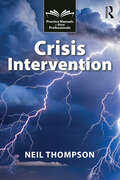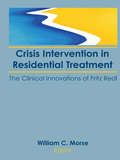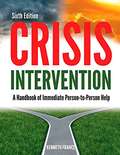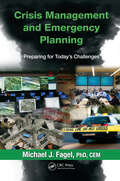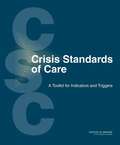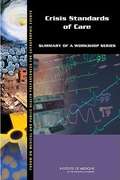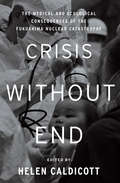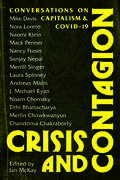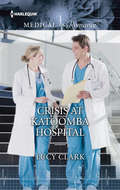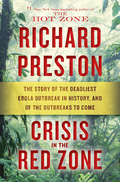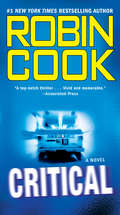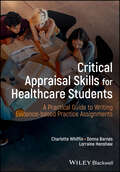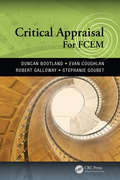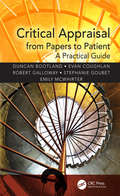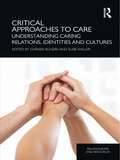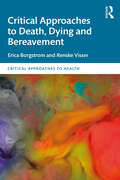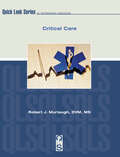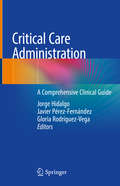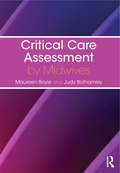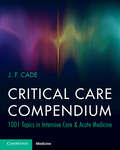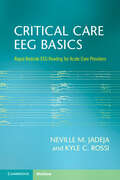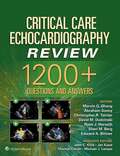- Table View
- List View
Crisis Gardening: A Global Perspective (Advances in Agroecology)
by Monika EgererGardening during times of crisis can have significant benefits to individuals and populations interms of health, well-being, social and economic outcomes. So-called ‘crisis gardening’ can even belinked to transformative change in food systems through socio-ecological aspects of agroecology.In this book, crisis gardening is explored to better define, describe and provide recommendationsabout this activity globally. Diverse perspectives are offered from scholars around the world, providingan overview of gardening during crises with ties to agroecology. Such a perspective is criticalas we grapple with food system crises, pandemics, climate change, biodiversity loss, mental healthissues and political conflict globally.• The first section defines and explains crisis gardening in relation to agroecology, transformative change in food systems and public health.• The second section describes case studies from around the world of crisis gardening from various social-ecological perspectives.• The third section provides policy and practice recommendations and how to scale up the lessons from crisis gardening to transform food systems, public health systems, and policy and landscape planning processes.Bringing together leaders and experts (academics, policy makers and practitioners) from around theworld, the book provides case studies of crisis gardening and develops recommendations to harnessthe lessons from this practice.
Crisis Intervention (Practice Manuals for Busy Professionals)
by Neil ThompsonThis new edition provides essential reading on crisis intervention for social workers, mental health nurses and other human services practitioners and managers. What defines a crisis can often be misunderstood and incorrectly equated with emergencies. This book explores crisis theory in depth, providing updated and refreshed guidance on what a crisis entails and how to effectively manage traumatic situations. In three distinct parts, the text challenges the dominant individualistic thinking about crises and instead adopts a holistic focus. It expands on crisis theory, examines the implications arising from crises, including links with trauma and the need to address discrimination and oppression. Key points, tips, opportunities for reflection and illustrative case studies are provided to aid understanding and help readers feel confident in tackling crisis intervention to bring about positive outcomes.
Crisis Intervention in Residential Treatment: The Clinical Innovations of Fritz Redl
by William C MorseAll settings where disturbed children spend time, such as camps or residential schools, are periodically faced with crisis situations. Methods for dealing with these crises and for counseling the children involved are continually needed. Crisis Intervention in Residential Treatment is both a demonstration of how essential Fritz Redl’s treatment concepts remain today and a tribute to his genius. The authors bring order and reason to the quest for better ways to understand and respond to confrontation and aggression in residential treatment settings. They provide practical and successful strategies to cope with these situations and prevent them from occurring. By exploring and expanding some of Redl’s most important theories and practices, the authors encourage a new generation of child care workers to find the same stimulation and satisfaction in his work as his original followers found. The contributors, each deeply affected and influenced in his or her own way by Redl, provide not only a moving tribute to a great child care worker and innovator, but also a rejuvenation of some of the most valued ideas in the field.Sharing Redl’s concern for daily practice with very difficult youngsters, this understanding book focuses on the action setting and the development of theory from practice, not the application of theory to practice. By concentrating on such topics as the use of life space interviewing, aggression and counter-aggression in staff, and the contrast of interpersonal and ecological perspectives with current “get tough” approaches, Crisis Intervention in Residential Treatment is an eminently useful guide for everyone dealing with children in group settings. Psychiatrists, psychologists, social workers, teachers, and residential personnel will all learn effective ways of coping with and preventing crisis situations.
Crisis Intervention: A Handbook Of Immediate Person-to-person Help
by Kenneth FranceIn this exceptional new sixth edition, the author has retained the practical framework for offering immediate problemsolving assistance to persons in crisis. Therefore, the goal of this updated and expanded edition is to provide knowledge and methods applicable to particular crisis circumstances. Specific topics include: core concepts that are fundamental to all intervention efforts, crisis theory and the philosophy of crisis intervention, basic communication and problemsolving skills, suicide prevention, assistance for terminally ill persons, bereavement counseling, intervention with crime victims, rape counseling, negotiating with armed perpetrators, group strategies, family and marital interventions, disaster relief, case management, physical facilities, modes of contact, community relations, selection, training, and burnout prevention procedures. The handbook also details a review of the research on crisis intervention and how individual intervenors can build upon that knowledge. Numerous case examples presented in the handbook (with fictitious names) are based on actual occurrences the author has encountered. The techniques in this book are applicable to crisis centers, hotlines, Internetbased services, victimassistance programs, college counseling centers, hospitals, schools, correctional facilities, children and youth programs, and other human service settings. The Study Questions at the end of each chapter are designed to serve as useful applications of crisis intervention theories and principles. Intended for caregivers whose work involves crisis intervention efforts, this is an informative resource for counselors, social workers, psychologists, nurses, physicians, clergy, correctional officers, parole and probation officers, and lay volunteers.
Crisis Management and Emergency Planning: Preparing for Today's Challenges
by Michael J. FagelEmergency managers and officials have seen a tremendous increase in the planning responsibilities placed on their shoulders over the last decade. Crisis Management and Emergency Planning: Preparing for Today's Challenges supplies time-tested insights to help communities and organizations become better prepared to cope with natural and manmade disas
Crisis Management in Acute Care Settings: Human Factors, Team Psychology, and Patient Safety in a High Stakes Environment
by Gesine Hofinger Cornelius Buerschaper Michael St. Pierre Robert SimonCritical situations in acute and emergency care are one of the great clinical challenges because of the uncertainty, high stakes, time pressure, and stress that are involved. This book provides a comprehensive outline of all the human factors issues relevant to patient safety during acute care. Following an initial section discussing the basic principles of human behavior and decision making, the various influences on safe patient care are discussed in depth. These are divided into three interacting groups: individual factors, team factors, and organizational factors. Relevant psychological theories are carefully examined, and case studies and descriptions of proven strategies help to ground these theories in daily practice. This newly revised edition, in which each chapter has been enlarged and updated, will help both physicians and non-physicians to better understand the principles of human behavior and decision making in critical situations and thus to provide safer treatment.
Crisis Standards of Care
by Institute of Medicine Board on Health Sciences Policy Committee on Crisis Standards of Care: A Toolkit for indicators and TriggersDisasters and public health emergencies can stress health care systems to the breaking point and disrupt delivery of vital medical services. During such crises, hospitals and long-term care facilities may be without power; trained staff, ambulances, medical supplies and beds could be in short supply; and alternate care facilities may need to be used. Planning for these situations is necessary to provide the best possible health care during a crisis and, if needed, equitably allocate scarce resources. Crisis Standards of Care: A Toolkit for Indicators and Triggers examines indicators and triggers that guide the implementation of crisis standards of care and provides a discussion toolkit to help stakeholders establish indicators and triggers for their own communities. Together, indicators and triggers help guide operational decision making about providing care during public health and medical emergencies and disasters. Indicators and triggers represent the information and actions taken at specific thresholds that guide incident recognition, response, and recovery. This report discusses indicators and triggers for both a slow onset scenario, such as pandemic influenza, and a no-notice scenario, such as an earthquake. Crisis Standards of Care features discussion toolkits customized to help various stakeholders develop indicators and triggers for their own organizations, agencies, and jurisdictions. The toolkit contains scenarios, key questions, and examples of indicators, triggers, and tactics to help promote discussion. In addition to common elements designed to facilitate integrated planning, the toolkit contains chapters specifically customized for emergency management, public health, emergency medical services, hospital and acute care, and out-of-hospital care.
Crisis Standards of Care: Summary of a Workshop Series
by Institute of Medicine of the National AcademiesDuring a wide-reaching catastrophic public health emergency or disaster, existing surge capacity plans may not be sufficient to enable healthcare providers to continue to adhere to normal treatment procedures and follow usual standards of care. This is a particular concern for emergencies that may severely strain resources across a large geographic area, such as a pandemic influenza or the detonation of a nuclear device. Under these circumstances, it may be impossible to provide care according to the standards of care used in non-disaster situations, and, under the most extreme circumstances, it may not even be possible to provide basic life sustaining interventions to all patients who need them. Although recent efforts to address these concerns have accomplished a tremendous amount in just a few years, a great deal remains to be done in even the most advanced plan. This workshop summary highlights the extensive work that is already occurring across the nation. Specifically, the book draws attention to existing federal, state, and local policies and protocols for crisis standards of care; discusses current barriers to increased provider and community engagement; relays examples of existing interstate collaborations; and presents workshop participants' ideas, comments, concerns, and potential solutions to some of the most difficult challenges.
Crisis Without End: The Medical and Ecological Consequences of the Fukushima Nuclear Catastrophe
by Helen CaldicottExpert essays provide the first comprehensive analysis of the long-term health and environmental consequences of the Fukushima nuclear accident. On the second anniversary of the Fukushima disaster, an international panel of leading medical and biological scientists, nuclear engineers, and policy experts were brought together at the prestigious New York Academy of Medicine by Helen Caldicott, the world&’s leading spokesperson for the antinuclear movement. This was the first comprehensive attempt to address the health and environmental damage done by one of the worst nuclear accidents of our times. A compilation of these important presentations, Crisis Without End represents an unprecedented look into the profound aftereffects of Fukushima. In accessible terms, leading experts from Japan, the United States, Russia, and other nations weigh in on the current state of knowledge of radiation-related health risks in Japan, impacts on the world&’s oceans, the question of low-dosage radiation risks, crucial comparisons with Chernobyl, health and environmental impacts on the United States (including on food and newborns), and the unavoidable implications for the US nuclear energy industry. Crisis Without End is both essential reading and a major corrective to the public record on Fukushima.
Crisis and Contagion: Conversations on Capitalism and Covid-19
by Ian McKayCrisis and Contagion is a selection of fourteen interviews conducted by Ian McKay of the Wilson Institute at McMaster University. Interviews with Nancy Fraser, Mike Davis, Mack Penner, Andreas Malm, and Merrill Singer explore capitalism’s organic crisis and the ways it has made this and future pandemics inevitable. Nora Loreto, Tithi Bhattacharya, Chandrima Chakraborty, Merlin Chowkwanyun, and Sanjay Nepal discuss the experiences of ordinary people in the pandemic. J. Michael Ryan, Laura Spinney, Naomi Klein, and Noam Chomsky explore the long-term effects and likely historical legacy of a pandemic that has changed millions of lives–and, maybe, the trajectory of human civilization. These scholars propose that to understand the impact of Covid-19, we have to understand the conflictual history of capitalism–and to ward off future pandemics, we need to start building a post-capitalist alternative to the disease-generating and highly unequal global neoliberal order. As capitalist forces work to shove what we have learned from the Covid-19 pandemic down the memory hole, Crisis and Contagion offers a must-read for those wanting to seize this moment of change and revolution.
Crisis at Katoomba Hospital
by Lucy ClarkAfter his challenging time as a doctor on the front line, Dr Stephen Brooks needs somewhere to unwind. What better place than the tranquil retreat of the Blue Mountains? And although romance is the last thing on his mind, after meeting his stunning new colleague, Stephen finds relaxing a little difficult.
Crisis in the Red Zone: The Story of the Deadliest Ebola Outbreak in History, and of the Outbreaks to Come
by Richard PrestonThe 2013–2014 Ebola epidemic was the deadliest ever—but the outbreaks continue. Now comes a gripping account of the doctors and scientists fighting to protect us, an urgent wake-up call about the future of emerging viruses—from the #1 bestselling author of The Hot Zone, now a National Geographic original miniseries. <P><P> This time, Ebola started with a two-year-old child who likely had contact with a wild creature and whose entire family quickly fell ill and died. The ensuing global drama activated health professionals in North America, Europe, and Africa in a desperate race against time to contain the viral wildfire. <P><P>By the end—as the virus mutated into its deadliest form, and spread farther and faster than ever before—30,000 people would be infected, and the dead would be spread across eight countries on three continents. In this taut and suspenseful medical drama, Richard Preston deeply chronicles the outbreak, in which we saw for the first time the specter of Ebola jumping continents, crossing the Atlantic, and infecting people in America. <P><P> Rich in characters and conflict—physical, emotional, and ethical—Crisis in the Red Zone is an immersion in one of the great public health calamities of our time. Preston writes of doctors and nurses in the field putting their own lives on the line, of government bureaucrats and NGO administrators moving, often fitfully, to try to contain the outbreak, and of pharmaceutical companies racing to develop drugs to combat the virus. He also explores the charged ethical dilemma over who should and did receive the rare doses of an experimental treatment when they became available at the peak of the disaster. <P><P> Crisis in the Red Zone makes clear that the outbreak of 2013–2014 is a harbinger of further, more severe outbreaks, and of emerging viruses heretofore unimagined—in any country, on any continent. In our ever more interconnected world, with roads and towns cut deep into the jungles of equatorial Africa, viruses both familiar and undiscovered are being unleashed into more densely populated areas than ever before. <P><P>The more we discover about the virosphere, the more we realize its deadly potential. Crisis in the Red Zone is an exquisitely timely book, a stark warning of viral outbreaks to come. <P><P><b> A New York Times Bestseller</b>
Critical (Jack Stapleton / Laurie Montgomery #7)
by Robin CookAngela Dawson, M.D., appears to have it all: at age thirty-seven, she owns a fabulous New York City apartment and a stunning seaside house on Nantucket, and enjoys the perks of her prosperous lifestyle. But her climb to the top has been rough, marked by a troubled childhood, a failed marriage, and the devastating blow of bankruptcy as a primary-care internist. Painfully aware of the role of economics in the health-care field, Angela returns to school to earn an MBA; she is determined to erase the memories of the controlling men in her past. Armed with a shiny new degree and blessed with tenacity, intelligence, and impeccable timing, Angela founds a start-up, Angels Healthcare, then prepares to take it public. With a controlling interest in three busy specialty hospitals in New York City and plans for others in Miami and Los Angeles, the future looks very bright for her. Confident in her abilities as both doctor and businesswoman, and virtually assured of finally controlling her own destiny, Angela is on the verge of seeing her ambitions fulfilled. But then a surge of drug-resistant staph infections in all three hospitals devastates Angela's carefully constructed world. Not only do the infections result in deaths of patients, but the fatalities cause a serious cash-flow problem, which puts her company's imminent IPO in jeopardy. And that's not all: Angela has serious doubts about her investors and the sources of their money, and the need for a sudden infusion of additional cash becomes all the more desperate. In the blink of an eye, after all her years of hard work, she may be left empty-handed. Vowing to keep her business afloat, Angela works around the clock to save what she built-knowing all too well that the only person she can count on is herself. New York City medical examiners Laurie Montgomery and Jack Stapleton are naturally intrigued by the uptick in staph-related postprocedure deaths at the three hospitals. Aside from their own professional curiosity, there's a personal stake as well: they are newly married, and Jack is facing surgery to repair a torn ACL at Angels Orthopedic Hospital. Despite Jack's protests, Laurie can't help investigating-thus opening a Pandora's box of corporate intrigue that threatens not just her livelihood, but her life and Jack's as well.
Critical Appraisal Skills for Healthcare Students: A Practical Guide to Writing Evidence-based Practice Assignments
by Charlotte J. Whiffin Donna Barnes Lorraine HenshawCritical Appraisal Skills for Healthcare Students Are you struggling to make sense of complex research papers and craft insightful critiques for your academic assignments? Then look no further! Critical Appraisal Skills for Healthcare Students is your indispensable guide to understanding research papers, mastering critical appraisal, and most importantly, succeeding in your summative assignments. While this text is written with Level 5 students in mind, you will find it is a useful text at any academic level when required to engage in evidence-based practice. In today’s ever-evolving healthcare system, the ability to critically appraise research evidence is crucial. In pre-registration programmes, this core skill is often assessed through written assignments. However, students can struggle not only to interpret research papers and evaluate their quality, but also to write about this appraisal in an academic way. This comprehensive textbook equips healthcare students with the evidence skills they need, while also enhancing their ability to produce high-quality assignments. Authored by experienced academics with over two decades of teaching research and evidence-based practice, this text covers core topics such as: The significance of evidence in practice, locating and selecting appropriate literature, and navigating assignments based on the appraisal of research Strategies for reading research papers and understanding them before appraisal The fundamentals of critiquing research, with Key Fact sheets summarising the design issues of specific types of research How to move beyond EBP for academic assessment, towards using evidence in everyday professional practice Critical Appraisal Skills for Healthcare Students is an excellent core text to master the art of critical appraisal and enhance academic performance.
Critical Appraisal for FCEM
by Duncan Bootland Evan Coughlan Robert Galloway Stephanie GoubetThe ability to read a paper, judge its quality, the importance of its results, and make a decision about whether to change practice based on the information given, is a core skill for all doctors. To be able to do this quickly and efficiently is, without a doubt, a skill needed by all time-pressured emergency doctors and one which is tested in the
Critical Appraisal from Papers to Patient: A Practical Guide
by Duncan Bootland Emily Mcwhirter Evan Coughlan Robert Galloway Stephanie GoubetHaving an understanding of critical appraisal and evidence-based medicine is a prerequisite to being an effective clinician.? However, critical appraisal is often taught by people not involved in day-to-day clinical care, meaning the clinical relevance is not always brought to the fore. This book takes a different approach. It is written by clinicians, for clinicians. It takes the reader step by step through the process so that any journal article can be easily read, evidence evaluated and the results - and their reliability - truly understood. By integrating this with knowledge of local skills and resources and patient preference, the reader will be able to apply the best possible care that his or her patients deserve. This accessible book is suitable for undergraduates and postgraduates of all medical specialties, nursing, paramedics, pharmacists and all allied health professions. It is the ideal reference for anyone needing help writing a clinical topic review, reviewing a paper in a journal club or preparing for a critical appraisal exam. But most importantly, it is essential for those who wish to practice medicine in the best possible way for their patients, using the best evidence, tailored to the individual.
Critical Approaches to Care: Understanding Caring Relations, Identities and Cultures (Relationships and Resources)
by Chrissie Rogers Susie WellerWhat does ‘care’ mean in contemporary society? How are caring relationships practised in different contexts? What resources do individuals and collectives draw upon in order to care for, care with and care about themselves and others? How do such relationships and practices relate to broader social processes? Care shapes people’s everyday lives and relationships and caring relations and practices influence the economies of different societies. This interdisciplinary book takes a nuanced and context-sensitive approach to exploring caring relationships, identities and practices within and across a variety of cultural, familial, geographical and institutional arenas. Grounded in rich empirical research and discussing key theoretical, policy and practice debates, it provides important, yet often neglected, international and cross-cultural perspectives. It is divided into four sections covering: caring within educational institutions; caring amongst communities and networks; caring and families; and caring across the life-course. Contributing to broader theoretical, philosophical and moral debates associated with the ethics of care, citizenship, justice, relationality and entanglements of power, Critical Approaches to Care is an important work for students and academics studying caring and care work in the fields of health and social care, sociology, social policy, anthropology, education, human geography and politics.
Critical Approaches to Death, Dying and Bereavement (Critical Approaches to Health)
by Renske Visser Erica BorgstromThis book is the first of its kind to examine key topics in death, dying, and bereavement through a critical lens, highlighting how the understanding and experience of death can vary considerably, based on social, cultural, historical, political, and medical contexts. It looks at the complex ways in which death and dying are managed, from the political level down to end- of- life care, and the inequalities that surround and impact experiences of death, dying, and bereavement.Readers are introduced to key theories, such as the medicalisation of dying, as well as contemporary issues, such as social movements, pandemics, and assisted dying. The book stresses how death is not only a biological process or event but rather shaped by a range of intersecting factors. Issues of inequalities in health, inequities in support, and intersectional analyses are brought to the fore, and each chapter is dedicated to an issue that has interdisciplinary resonance, thus showcasing the wider sociocultural and political factors that impact this time of life.This book is valuable reading for scholars in thanatology and death studies, and for those in related fields such as sociology of health, medical and social anthropology, and interdisciplinary social science courses.
Critical Care
by Robert MurtaughFocusing on the basic science behind critical injury and treatment, this book discusses fluid and electrolytes, critical care support, multi-systemic disorders and critical care diseases. Pathophysiologic mechanisms behind critical injury are combined with core clinical content so the user may develop effective clinical judgments and formulate guidelines for patient assessment, diagnosis and treatment planning. The book features a very clear, easy to understand acid/base balance discussion with over 200 original conceptual drawings that facilitate understanding and 200 multiple choice questions for comprehension.
Critical Care (Mercy Hospital #1)
by Candace CalvertAFTER HER BROTHER DIES IN A TRAUMA ROOM, nurse Claire Avery can no longer face the ER. She's determined to make a fresh start—new hospital, new career in nursing education— move forward, no turning back. But her plans fall apart when she's called to offer stress counseling for medical staff after a heartbreaking day care center explosion. Worse, she's forced back to the ER, where she clashes with Logan Caldwell, a doctor who believes touchy-feely counseling is a waste of time. He demands his staff be as tough as he is. Yet he finds himself drawn to this nurse educator . . . who just might teach him the true meaning of healing.
Critical Care Administration: A Comprehensive Clinical Guide
by Jorge Hidalgo Javier Pérez-Fernández Gloria Rodríguez-VegaThis book provides a state-of-the-art overview on critical care administration. The text reviews important aspects and considerations involved in developing an efficient, cost-effective critical care program, while maintaining a safe and high-quality work environment. Major topics covered include different models of critical care services, planning and budgeting, administration support, staffing models, tele/smart ICU, protocols and guidelines, and disaster preparedness and management.Written by experts in the field, Critical Care Administration: A Comprehensive Clinical Guide is a practical, handy resource for critical care professionals involved in the administration and management of ICUs.
Critical Care Assessment by Midwives
by Maureen Boyle Judy BothamleyOver the last ten years, pregnancy has not only become more complicated for many women, but the traditional provision of general intensive care units has been reduced. To bridge this gap, critical care units, usually staffed by midwives, have been set up in many maternity units. This textbook is an accessible and comprehensive introduction to this emerging area of practice. Critical Care Assessment by Midwives also notably sets out a template for assessment of women that will enable early identification of deteriorating health. Serious illness can arise subsequent to an emergency, a pre-existing illness or a complication of pregnancy but can also occur in the context of what appears to be a low risk pregnancy. For this reason, all midwives need to be skilled in assessment that facilitates timely, appropriate referrals and saves lives. It covers: ABCDE assessment tailored for midwives; assessment of cardiac conditions; aassessment of respiratory conditions; assessment of neurological conditions; pre-eclampsia; haemorrhage; shock, including hypovolaemia, sepsis and anaphylaxis; haemodynamic monitoring; fluid replacement and balance; ketoacidosis, hypoglycaemia and sickle cell crisis. Covering the context of care, relevant pathophysiology, signs and symptoms, specific assessment in detail, relevant drugs, assessment of the fetus, summaries of management, psychosocial support and the specific professional responsibilities of the midwife, this is an essential guide for all midwives and midwifery students.
Critical Care Compendium: 1001 Topics in Intensive Care & Acute Medicine
by J. F. CadeUncommon clinical problems can present serious challenges in any medical specialty, particularly in those areas providing acute care. Bringing together all uncommon problems relevant to the treatment of seriously ill patients in a quick one-stop reference, this book is an easy-to-use and practical reference for the clinician at any level faced with an uncommon acute medical problem at the bedside. Using a popular A-Z format, over 1000 entries reflect the current breadth of the specialty's extension to hospital-wide issues of acute care. Each topic contains both essential diagnostic and treatment information and discusses the implications for intensive care management. Extensive cross-referencing throughout aids rapid access to key information and the use of cartoons enhances learning. The book offers a source of reference for the many issues so often overlooked in major textbooks, which can be difficult not only to locate elsewhere but also for experienced clinicians to remember in detail. An invaluable resource within a single volume for intensivists, anaesthetists, emergency specialists, and a wide range of other healthcare professionals.
Critical Care EEG Basics: Rapid Bedside EEG Reading for Acute Care Providers
by Neville M. Jadeja Kyle C. RossiEasy to read and well-illustrated, this unique guidebook is written for acute care providers of all backgrounds and skill levels, who may be unfamiliar with basic EEG concepts and dependent on reading EEG reports or remote interpretations. This guide introduces the basics of critical care EEG with an emphasis on the skill of real-time bedside EEG reading (pattern recognition). It is presented in two parts using case-based approaches and is full of clinical tips. Readers will become familiar with common critical care EEG patterns, their significance, and management with relevant reasoning. They will also learn how to make basic bedside EEG interpretations to supplement their clinical neurological exam and better collaborate with EEG readers. A dedicated chapter on quantitative EEG explains this important modality. In short, this book enables the use of critical care EEG as a powerful extension to the clinical assessment of critically ill patients.
Critical Care Echocardiography Review: 1200+ Questions and Answers
by Sheri Berg Abraham Sonny Marvin G Chang David Dudzinski Christopher R Tainter Ryan J Horvath Edward BittnerPrepare for success on the Examination of Special Competence in Critical Care Echocardiography (CCEeXAM)! Critical Care Echocardiography Review is a first-of-its-kind, review textbook containing over 1,200 questions and answers. Helmed by Drs. Marvin G. Chang, Abraham Sonny, David Dudzinski, Christopher R. Tainter, Ryan J. Horvath, Sheri M. Berg, Edward A. Bittner as well as a team of associated editors and authors from institutions across the nation , this highly visual resource covers every aspect of the use of ultrasound for clinical diagnosis and management in the critical care setting, providing a thorough, effective review and helping you identify areas of mastery and those needing further study.

